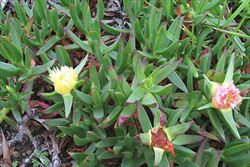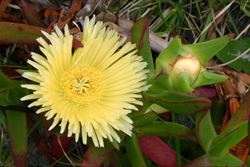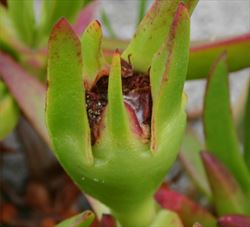Click on images to enlarge

habit (Photo: Trevor James)

habit (Photo: Jackie Miles and Max Campbell)

leaves and flower (Photo: Trevor James)

fleshy paired leaves (Photo: Trevor James)

close-up of three-sided leaves (Photo: Trevor James)

flower and flower bud (Photo: Trevor James)

close-up of immature fruit (Photo: Trevor James)
Scientific Name
Carpobrotus edulis (L.) N.E. Br.
Synonyms
Carpobrotus acinaciformis auct. non (L.) L. BolusCarpobrotus edulis (L.) N.E. Br. subsp. edulisMesembryanthemum acaciniformis L. (misapplied)Mesembryanthemum edule L.
Family
Aizoaceae
Common Names
Cape fig, common Hottentot fig, fig marigold, glaucous pigface, highway iceplant, Hottentot fig, ice plant, iceplant, introduced pigface, pigface, sour fig, sourfig
Origin
Native to South Africa.
Naturalised Distribution
Widely naturalised in southern Australia, but mainly restricted to coastal districts. It is sparingly naturalised in south-eastern Queensland, naturalised mainly in the coastal districts of central and southern New South Wales and Victoria, and naturalised in south-western Western Australia, Tasmania, and south-eastern South Australia (i.e. extending throughout the coastal regions of the Eyre Peninsula, Yorke Peninsula, Northern Lofty, Murray, South East and Kangaroo Island regions).
Also naturalized in the USA (i.e. California and Florida), Mexico, South America (i.e. Chile and Argentina), Europe (i.e. Portugal, Italy, France, the United Kingdom, Ireland, Germany, Spain, Gibraltar, Malta, Albania and Greece), northern Africa (i.e. Tunisia), New Zealand and French Polynesia.
Habitat
This species becomes naturalised in coastal environs, winter-wet depressions, sandy pastures, and open woodlands in temperate and sub-tropical regions.
In New Zealand it also grows on cliffs, along railways, and in roadside cuttings and in the USA it grows in river estuaries.
Habit
A long-lived (i.e. perennial), creeping (i.e. prostrate), plant usually less than 30 cm tall with spreading stems up to 2 m or more long.
Distinguishing Features
-
a creeping fleshy plant with spreading stems up to 2 m or more long.
-
its stems grow on or just below the surface and produce roots at their joints.
-
its fleshy leaves are stalkless and triangular in cross-section.
-
its large and showy yellow flowers (7-8.5 cm across) have numerous 'petals' are borne singly.
-
its fleshy fruit (2-3 cm across) turn yellowish to reddish-purple as they mature.
Stems and Leaves
The thick, fleshy (i..e. succulent) stems grow on or just below the surface and produce roots (i.e. adventitious roots) at their joints (i.e. nodes).
The fleshy (i.e. succulent) leaves are stalkless (i.e. sessile) and oppositely arranged along the stems. These leaves are elongated in shape (4-10 cm long and 5-17 mm wide) and triangular in cross-section. They are dark or dull green in colour (often with a reddish tinge), slightly incurved, with pointed tips (i.e. acute apices). The stems and leaves are also hairless (i.e. glabrous).
Flowers and Fruit
The large and showy yellow flowers (7-8.5 cm across) are borne singly at the tips of short side branches (i.e. solitary and terminal on lateral branches). They are borne on a fleshy stalk (i.e. they are pedicellate) and have numerous false 'petals' (30-35 mm long and 1.5-2.5 mm wide). The true petals resemble the fleshy (i.e. succulent) leaves and their bases are fused into a tube (i.e. perianth tube) 15-25 mm long around the ovary. Two of these petals are larger (20-45 mm long), almost opposite and closely resemble the leaves. The structures that mimic petals are actually derived from modified stamens (i.e. they are petaloid staminodes). There are about 120-130 of these in each flower and they are arranged in 3-5 rows. They are yellow with whitish coloured bases, but may turn pinkish with age. Each flower also has very large numbers of stamens (i.e. approx. 400-600) that are arranged in about 6 or 7 rows. The ovary has 8-10 compartments and is topped with the same number of styles (7-15 mm long). The flowering period extends from late summer to winter.
The fruit are fleshy (i.e. succulent), rounded in shape (i.e. globular or sub-globose) and turn yellowish to reddish-purple in colour as they mature. These fruit (2-3 cm across) contain numerous seeds that are embedded in mucilage.
Reproduction and Dispersal
This species reproduces by seed and also vegetatively via its fleshy stems.
Plants spread laterally by vegetative reproduction once established, with individual segments growing up to 1m per year. Pieces of stem segments and seeds are spread to new areas in dumped garden waste. The seeds can be also dispersed significant distances when birds and other animals eat the mature fruit.
Environmental Impact
Hottentot fig (Carpobrotus edulis) is regarded as a significant environmental weed in Victoria, South Australia and Western Australia. This species can form impenetrable mats that cover the ground, smother native species, and reduce the regeneration of native flora. It can even totally displace native plant communities on sand dunes and destroy coastal habitats in its path. It also causes sand dunes to become stabilised by preventing sand movement, which hinders the natural processes of disturbance and change in dune environments, and significantly reduces the biological diversity of dune vegetation.
There is also a concern that Hottentot fig (Carpobrotus edulis) may hybridise with closely related native species, such as Ross's pigface (Carpobrotus rossii), reducing their integrity and genetic purity. In Western Australia hybrids of Hottentot fig (Carpobrotus edulis) and the native coastal pigface (Carpobrotus virescens) have been recorded.
Other Impacts
It is also a minor weed of pastures on coastal sandy soils.
Legislation
Not declared or considered noxious by any state government authorities.
Similar Species
Hottentot fig (Carpobrotus edulis) is very similar to the introduced angular pigface (Carpobrotus aequilaterus) and several native pigfaces (i.e. Carpobrotus glaucescens, Carpobrotus modestus, Carpobrotus rossii and Disphyma crassifolium subsp. clavellatum). These species can be distinguished by the following differences:
- Hottentot fig (Carpobrotus edulis) has relatively large yellow flowers (7-8.5 cm across), that sometimes turn pinkish as they mature, and its leaves are three-sided in cross-section. Its 'petals' (i.e. petaloid staminodes) are white towards the base and each flower has 400-600 stamens.
- angular pigface (Carpobrotus aequilaterus) has relatively large pink or light purple flowers (3.5-8 cm across) and its leaves are three-sided in cross-section. Its 'petals' (i.e. petaloid staminodes) are paler, but not white, towards the base and each flower has 250-400 stamens.
- native pigface (Carpobrotus glaucescens) has relatively large pink or light purple flowers (4-6 cm across) and its leaves are three-sided in cross-section. Its 'petals' (i.e. petaloid staminodes) are white towards the base and each flower has 300-400 stamens.
- inland pigface (Carpobrotus modestus) has relatively small pink or purplish flowers (less than 2 cm across) and its leaves are three-sided in cross-section. Its 'petals' (i.e. petaloid staminodes) are white towards the base and each flower has 20-80 stamens.
- Ross's pigface (Carpobrotus rossii) has relatively large pink or purplish flowers (3.5-5.5 cm across) and its leaves are three-sided in cross-section. Its 'petals' (i.e. petaloid staminodes) are white towards the base and each flower has 100-250 stamens.
- round-leaves pigface (Disphyma crassifolium subsp. clavellatum) has moderately large pink or purplish flowers (2-5 cm across) and its leaves are rounded in cross-section. Its 'petals' (i.e. petaloid staminodes) are white towards the base and each flower has 100-250 stamens.

